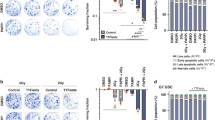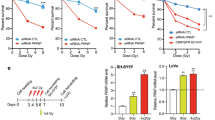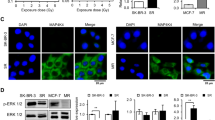Abstract
The observed radioresistance of human glioblastoma multiforme (GBM) poses a major challenge, which, if overcome, may lead to significant advances in the management of this patient population. There is accumulating evidence from correlative studies that Survivin expression is associated with increased malignant potential of human gliomas. The purpose of this study was to investigate whether Survivin plays a direct role in mediating radiation resistance in primary human glioma cell lines, and, if so, investigating the underlying mechanisms. Our panel of GBM cell lines included two that were relatively radiation resistant (GM20 and GM21) and two that were more radiation sensitive (GM22 and GM23), which demonstrated differential levels of Survivin expression between the two groups. Through the use of adenoviral vectors containing either dominant-negative (pAd-S(T34A)) or wild-type Suvrivin (pAd-S(WT)), we were able to inactivate or overexpress Survivin, respectively. Our findings suggest that Survivin plays a critical role in mediating radiation resistance in primary GBM cells, in part through suppression of apoptotic cell death via a caspase-independent manner. We have identified novel mechanisms by which Survivin may enhance tumor cell survival upon radiation exposure such as regulation of double-strand DNA break repair and tumor cell metabolism, which were most evident in the radiation-resistant cell lines. These differences in Survivin function both in radiation-resistant vs radiation-sensitive cell lines and in the presence vs absence of radiation exposure warrant further investigation and highlight potentially important mechanisms of radiation resistance in these tumors.
This is a preview of subscription content, access via your institution
Access options
Subscribe to this journal
Receive 50 print issues and online access
$259.00 per year
only $5.18 per issue
Buy this article
- Purchase on Springer Link
- Instant access to full article PDF
Prices may be subject to local taxes which are calculated during checkout









Similar content being viewed by others
References
Adida C, Berrebi D, Peuchmaur M and Al E . (1998). Lancet, 351, 882–883.
Adida C, Haioun C, Gaulard P, Lepage E, Morel P, Briere J, Dombret H, Reyes F, Diebold J, Gisselbrecht C, Salles G, Altieri DC and Molina TJ . (2000). Blood, 96, 1921–1925.
Altieri DC . (2003). Oncogene, 22, 8581–8589.
Ambrosini G, Adida C and Altieri DC . (1997). Nat. Med., 3, 917–921.
Ambrosini G, Adida C, Sirugo G and Altieri DC . (1998). J. Biol. Chem., 273, 11177–11182.
Asanuma K, Moriai R, Yajima T, Yagihashi A, Yamada M, Kobayashi H and Watanabe N . (2000). Jpn. J. Cancer Res., 91, 1204–1209.
Cande C, Cohen I, Daugas E, Ravagnan L, Larochette N, Zamzami N and Kroemer G . (2002). Biochimie, 84, 215–222.
Chakravarti A, Noll E, Black PM, Finkelstein DF, Finkelstein DM, Dyson NJ and Loeffler JS . (2002). J. Clin. Oncol., 20, 1063–1068.
Conway EM, Pollefeyt S, Cornelissen J, DeBacre I, Steiner-Mosonyi M, Ong K, Baens M, Colien D and Schuh AC . (2000). Blood, 95, 1435–1442.
Davis FG, McCarthy BJ, Freels S and Al E . (1999). Cancer, 85, 485–491.
Fortugno P, Wall NR, Giodini A, O'Connor DS, Plescia J, Padgett KM, Tognin S, Marchiso PC and Altieri DC . (2002a). J. Cell Sci., 115, 575–585.
Fortugno P, Wall NR, Giodini A, O'Connor DS, Plescia J, Padgett KM, Tognin S, Marchisio PC and Altieri DC . (2002b). J. Cell Sci., 115 (Part 3), 575–585.
Grossman D, Kim PJ, Schechner JS and Altieri DC . (2001). Proc Natl Acad Sci USA, 98, 635–640.
Hall EJ . (2000). Radiobiology for the Radiologist 5th edn. Lippincott Williams & Wilkins: Philadelphia.
Islam A, Kageyama H, Takada N, Kawamato T, Takayasu H, Isogai E, Ohira M, Hashizume K, Kobayashi H, Kaneko Y and Nakagawara A . (2000). Oncogene, 19, 617–623.
Jiang X, Wilford C, Duensing S, Munger K, Jones G and Jones D . (2001). J. Cell Biochem., 83, 342–354.
Kajiwara Y, Yamasaki F, Hama S, Yahara K, Yoshioka H, Sugiyama K, Arita N and Kurisu K . (2003). Cancer, 97, 1077–1083.
Katoh M, Wilmonte R, Belkouch M-C, de Tribolet N, Pizzolato G and Dietrich P-Y . (2003). J. Neurooncol., 64, 71–76.
Kawasaki H, Altieri DC, Lu CD and Al E . (1998). Cancer Res., 58, 5071–5074.
Kobayashi K, Hatano M, Otaki M, Ogasawara T and Tokuhisa T . (1999). Proc. Nat. Acad. Sci. USA, 96, 1457–1462.
Lang-Rollin I, Rideout H, Noticewala M and Stefanis L . (2003). J. Neuorosci., 23, 11015–11025.
Li F and Altieri DC . (1999). Biochem. J., 344, 305–311.
Lu CD, Altieri DC and Tanigawa N . (1998). Cancer Res., 58, 1808–1812.
Maher EA, Furnari FB, Bachoo RM, Rowitch DH, Louis DN, Cavenee WK and DePinho RA . (2001). Genes Dev., 15, 1311–1333.
Mangiardi J . (2001). Brain Tumors Kaye A, Laws E (eds). Churchill Livingston: New York City, pp. 105–117.
Merlo A . (2003). Neurosurg. Rev., 26, 145–158.
Mesri M, Wall NR, Li J, Kim RW and Altieri DC . (2001). J. Clin. Invest., 108, 981–990.
Monzo M, Rosell R, Felip E, Astudillo J, Sanchez JJ, Maestre J, Martin C, Font A, Barnadas A and Abad A . (1999). J. Clin. Oncol., 17, 2100–2104.
Olie RA, Simoes-Wust AP, Baumann B, Leech SH, Fabbro D, Stahel RA and Zangemeister-Wittke U . (2000). Cancer Res., 60, 2805–2809.
Sasaki T, Lopes MB, Hankins GR and Helm GA . (2002). Acta. Neuropathol, 104, 105–109.
Shin S, Sung BJ, Cho YS, Kim HJ, Ha NC, Hwang JI, Chung CW, Jung YK and Oh BH . (2001). Biochemistry, 40, 1117–1123.
Skoufias DA, Mollinari C, Lacroix FB and Margolis RL . (2000). J. Cell Biol., 151, 1575–1582.
Smith SD, Wheeler MA, Plescia J, Colberg JW, Weiss RM and Altieri DC . (2001). JAMA, 285, 324–328.
Tan EC, Leung T, Manser E and Lim L . (1993). J. Biol. Chem., 268, 27291–27298.
Tanaka K, Iwamoto S, Gon G, Nohara T, Iwamoto M and Tanigawa N . (2000). Clin. Cancer Res., 6, 127–134.
Walker MD, Alexander E and Hunt WE . (1978). J. Neurosurg., 49, 333–343.
Walker MD, Green SB and Byar DP . (1980). N. Engl. J. Med., 303, 1323–1329.
Westphal M, Hansel M, Nausch H, Rohde E and Hermann HD . (1990). Culture of Human Brain Tumors on an Extracellular Matrix Derived from Bovine Corneal Endothelial Cells and Cultured Human Glioma Cells, Vol 5. Humana Press: Clifton, NJ.
Wright ME, Han DK and Hockenbery DM . (2000). FEBS Lett., 481, 13–18.
Acknowledgements
We acknowledge the kind generosity of Dr Dario Altieri (University of Massachusetts Medical Center) for providing the following adenoviral constructs: pAd-S(T34A) and pAd-S(WT). This work was supported by grants NIH KO882163CA, Massachusetts General Hospital Brian D Silber Memorial Fund, Goldhirsh Brain Tumor Award (all to AC)
Author information
Authors and Affiliations
Corresponding author
Rights and permissions
About this article
Cite this article
Chakravarti, A., Zhai, G., Zhang, M. et al. Survivin enhances radiation resistance in primary human glioblastoma cells via caspase-independent mechanisms. Oncogene 23, 7494–7506 (2004). https://doi.org/10.1038/sj.onc.1208049
Received:
Revised:
Accepted:
Published:
Issue Date:
DOI: https://doi.org/10.1038/sj.onc.1208049
Keywords
This article is cited by
-
The DNA Double-Strand Break Repair in Glioma: Molecular Players and Therapeutic Strategies
Molecular Neurobiology (2022)
-
BIRC3 and BIRC5: multi‐faceted inhibitors in cancer
Cell & Bioscience (2021)
-
Foretinib induces G2/M cell cycle arrest, apoptosis, and invasion in human glioblastoma cells through c-MET inhibition
Cancer Chemotherapy and Pharmacology (2021)
-
The role of caveolin-1 in tumors of the brain - functional and clinical implications
Cellular Oncology (2019)
-
Chromosomal instability induced by increased BIRC5/Survivin levels affects tumorigenicity of glioma cells
BMC Cancer (2017)



